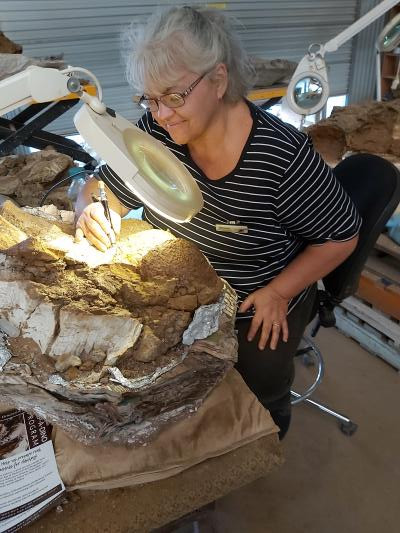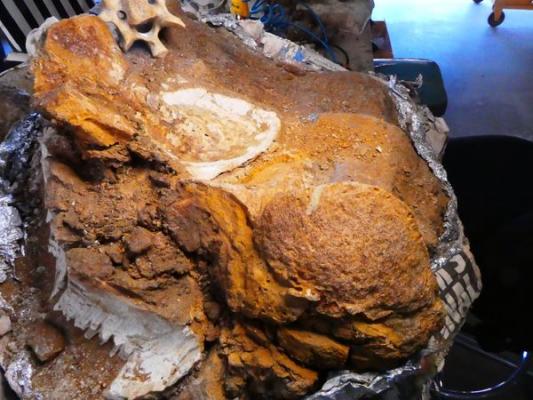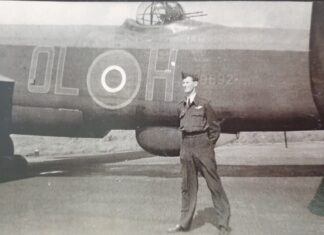Every year, since 2009, Gympie woman Di Woodstock travels back to around 90 million years ago to spend a couple of weeks with dinosaurs.
“I don’t think I’ve missed a year, actually,“ she said, “and my aunt flies over from New Zealand – when she can.“
She travels 1374kms north west to just outside Winton to volunteer with the Australian Age of Dinosaurs.
She first started out on the “digs“ unearthing dinosaur bones that no other human has ever seen before.
“My first dig was on probably their best known (dinosaurs) Matilda and Banjo who were found in the bottom of the billabong,“ she said.
Paleontologists believe Matilda (Diamantinasaurus matildae) was a sauropod from the early Cretaceous period who became stuck in the mud of the billabong when Banjo (Australovenator), an aggressive Allosaurus-like smaller predator came down to try and make a meal of her.
“The story is that she probably swung her tail and killed him – because they found both of the dinosaurs in the same spot,“ Di said.
“That was pretty cool – that was my very first dig – and since then I’ve also been on the dig, which was a couple of years ago now, where they found the flying reptile, which is the pterodactyl, which is all very exciting,“ she said.
“The big one that they’re working on at the moment is called Judy and that’s for Judy and David Elliot who are the founders of it all.
“It’s the most complete sauropod figure in Australia that they’re working on her at the moment up there.
“They’ve got most of her neck vertabrae and it’s articulated. They’ve worked out this dinosaur is literally a sub-adult and it fell over and died and got covered really quickly so it’s all still in situ and they think they’ve got the gut flora,“ she said.
While finding out what a dinosaur had for breakfast 95 million years ago doesn’t seem like a big thing, it’s actually really exciting from a scientific stand point.
“It hasn’t been confirmed yet but they believe it’s gut content and that will possibly change the way we look at long necked dinosaurs depending on what’s in it. If it’s mainly marine creatures, they know it’s feeding in the water which means it may have swam – we don’t know. So that’s all pretty cool,“ she said.
Di first got interested in dinosaurs in the 1970s on a trip to Lark Quarry.
“They have Lark Quarry which is the only dinosaur stampede in the world – which is massive.
“So they’ve got the little guys that were drinking at the edge of the water and suddenly this big one’s come in.
“It was probably one like Banjo, and it’s come barrelling in to catch something and they’ve all fled back past him.
“So the quarry has got all the footprints coming down to the water and then running backwards and then the big one is through the middle.
“At that stage (during the 70s) you could just walk in through a turnstile, to keep the animals out, and go in and have a look.
“You could actually sit there. There was a little table and chairs looking at where the stampede was and you could sit there and have a cup of tea or coffee.
“And you knew that they’d been there, because you could see their footprints, so you could actually imagine this herd of dinosaurs coming through the gully – it’s just amazing. You wouldn’t have wanted to be there but this is physical proof that they were there.
And that’s great.
“In a dig, when you actually uncover a bit of bone you’re the only person that has ever seen that.
“And even when you’re doing the prep work, which a lot of people think is tedious, you have that feeling.
“It’s very methodical and you’re cleaning it right back and getting the rock off the bone – because the bone’s soft – it’s a beautiful process.
“Those bones have never been seen – because their weren’t people back then,“ she said.
Getting the chance to go to Winton each year and volunteer is something Di looks forward to and was thankful that despite certain travel restrictions this year due to Covid-19, she was still able to participate.
She said anyone can get involved, but they need to be over the age of 12 and have completed a 10 day course.
“Once you’ve done your 10 days you get a badge and then you can go back anytime and just pay for your accommodation or whatever and go off and do it.
“It’s a phenomenal thing to be a part of because it’s something that not many people get a chance to do – but anybody can do it.
You don’t have to have any background.
“The Australian Age of Dinosaurs, I just think that they’re an awesome organisation – they’re not for profit and they support the local community big time.“
She said while the organisation doesn’t have flashy gimmicks, visitors to the compound are always impressed.
“It’s not like down the coast where they’ve got mechanical dinosaurs – it’s not like that. This is the process and the people. It’s not what most expect, but they’re always blown away by what they find,“ she said.
“Kid’s love it, but it’s also aimed at adults. Yes, they love the kids, definitely, and there’s huge amounts for kids to do but it’s very interesting for adults as well.“
Di is a passionate advocate for Australian dinosaurs and would like to see children embracing our “cooler“ sauropods and predators.
“I hate it when kids say, ’I’m having a birthday party and I’ve got T-Rex on my cake.’
“Why? Banjo is so much better. T-Rex has these silly little hands that he can’t do anything with and bites everything where as Banjo is quick – he runs fast because he’s got huge great big back legs and but he’s long arms that he’s got a sheath over his claws like a bird’s.
“So Banjo is run, hunt, grab, slash, chew. Whereas T-Rex is lumber, lumber, lumber, bite, bite, bite.
“We’ve got the most amazing dinosaurs and every single dinosaur that they find almost, is a new species which is pretty awesome.“







